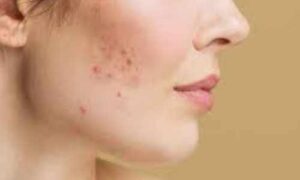SKIN ALLERGIES - AN OVERVIEW
SYMPTOMS OF SKIN ALLERGIES
The specific symptoms of skin allergies can vary based on the type of allergen, the individual’s sensitivity, and the duration of exposure. Additionally, prolonged or severe symptoms may call for consultation with a healthcare professional for proper diagnosis and treatment. If you suspect a skin allergy, avoiding potential triggers and seeking medical advice can help manage and alleviate symptoms effectively. Skin allergies occur in various ways, leading to observable symptoms. Common signs of skin allergies include:
Redness: Affected areas of the skin may appear red or flushed.
Itching: Itchy skin is a typical symptom, causing discomfort and a strong urge to scratch.
Swelling: Swelling, often accompanied by redness, can occur and may vary in severity.
Rash: The development of a rash, characterized by raised, red, or inflamed skin patches.
Hives (Urticaria): Raised welts on the skin that are often itchy and can change shape and location.
Dryness: Skin affected by allergies may become excessively dry or flaky.
Blisters: In some cases, skin allergies can lead to the formation of blisters or vesicles.
Burning Sensation: Individuals may experience a burning or tingling sensation on the affected skin.
Cracking or Peeling: Allergic reactions can result in the skin cracking or peeling, particularly in more severe cases.
Eczema (Dermatitis): Persistent inflammation may lead to conditions like eczema, characterized by dry, scaly patches.
Warmth: The affected skin may feel warm to the touch.
Pain: In some instances, skin allergies can cause pain or discomfort in the affected area.
CAUSES OF SKIN ALLERGIES
Skin allergies can be triggered by various substances, known as allergens. Common causes include:
Contact Allergens:
Plants: Poison ivy, poison oak, and poison sumac contain oils that can cause allergic reactions.
Metals: Nickel, found in jewelry, belts, and clothing fasteners, is a common metal allergen.
Latex: Allergic reactions can occur from contact with latex found in gloves, balloons, and certain medical products.
Topical Products:
Cosmetics: Certain ingredients in makeup, lotions, or skincare products can cause allergic skin reactions.
Hair dyes: Chemicals in hair dyes may trigger allergies in some individuals.
Medications:
Antibiotics: Some individuals may be allergic to antibiotics like penicillin or sulfa drugs.
Topical Medications: Allergic reactions can occur with certain creams, ointments, or topical medications.
Insect Bites and Stings:
Bee stings, mosquito bites, or bites from other insects can cause allergic reactions in sensitive individuals.
Environmental Allergens:
Pollen: Contact with pollen from plants and trees can trigger skin allergies.
Mold: Exposure to mold spores, often found in damp environments, can lead to allergic reactions.
Food Allergens:
Certain foods, such as nuts, shellfish, and dairy, may cause allergic skin reactions in susceptible individuals.
Fabrics and Dyes:
Dyes or chemicals used in clothing fabrics can lead to contact dermatitis.
Personal Care Products:
Fragrances and preservatives in soaps, shampoos, and detergents can be allergenic.
Genetic Predisposition:
Family history of allergies can increase the likelihood of developing skin allergies.
Airborne Allergens:
Airborne pollutants and irritants may contribute to skin allergies, especially in individuals with sensitive skin.
PREVENTION OF SKIN ALLERGIES
Preventing skin allergies involves minimizing exposure to known allergens and adopting practices that promote skin health. Here are key preventive measures:
Identify Allergens: Determine specific allergens through patch testing or allergy testing. Be aware of personal triggers, such as certain fabrics, cosmetics, or environmental factors.
Read Product Labels: Check the ingredients of skincare products, cosmetics, and household items. Choose fragrance-free and hypoallergenic products when possible.
Avoid Environmental Allergens: Monitor pollen and mold counts, especially during peak seasons. Use air purifiers to reduce indoor allergens.
Protect Against Insects: Wear protective clothing, such as long sleeves and pants, in areas prone to insect bites. Use insect repellents to minimize the risk of bites and stings.
Choose Clothing Wisely: Opt for natural, breathable fabrics like cotton. Wash new clothes before wearing them to remove potential irritants.
Minimize Metal Exposure: Select jewelry made from hypoallergenic materials. Coat items like buttons or belt buckles with clear nail polish to create a barrier.
Practice Good Personal Hygiene: Shower after outdoor activities to remove potential allergens. Use mild, fragrance-free soaps and detergents.
Be Cautious with Cosmetics: Patch-test new cosmetics before full application. Choose products labeled as hypoallergenic and free of common allergens.
Manage Stress: Practice stress-reduction techniques like meditation or yoga, as stress can exacerbate skin conditions.
Stay Informed: Stay updated on allergen information and product formulations. Consult healthcare professionals for guidance on managing skin allergies.
Regular Check-ups: Schedule regular dermatological check-ups, especially if prone to skin allergies. Seek prompt medical advice if new symptoms or reactions occur.
Sun Protection: Use sunscreen with broad-spectrum protection to prevent sun-related skin issues. Wear protective clothing and seek shade when outdoors.
Consult Healthcare Professionals: If prone to allergies, consult allergists or dermatologists for personalized advice. Discuss preventive measures and treatment options with healthcare providers.
DIAGNOSIS OF SKIN ALLERGIES
Diagnosing skin allergies involves a comprehensive assessment of symptoms, medical history, and, in some cases, specialized tests. Here are common diagnostic approaches:
Visual Inspection: A healthcare professional, often a dermatologist, examines the affected skin to observe signs of redness, itching, rash, or other allergic reactions.
Medical History: Details about the onset, duration, and patterns of symptoms are gathered to identify potential triggers.
Patch Testing: Identification of Allergens: Patch tests involve applying small amounts of common allergens to the skin using adhesive patches. Reactions over a specific period help identify allergens causing contact dermatitis.
Skin Prick Test: Allergen Exposure: Small amounts of suspected allergens are pricked into the skin’s surface. Any resulting skin reaction helps identify specific allergens responsible for allergic reactions.
Blood Tests: Specific IgE Tests: Blood tests measure the levels of specific IgE antibodies, helping identify allergens associated with skin allergies. Common tests include RAST (Radioallergosorbent test) or ImmunoCAP.
Elimination Diet: Identifying Food Allergies: If food allergies are suspected, an elimination diet may be recommended. Certain foods are temporarily removed, and their gradual reintroduction helps identify trigger foods.
Allergen Injection: Small amounts of allergens are injected under the skin to observe immune system reactions. This is less commonly used compared to skin prick tests.
Photopatch Testing: Light-Induced Allergies: In cases of photosensitive skin reactions, photopatch testing may be conducted to identify allergens triggered by sunlight.
Biopsy: Tissue Examination: In certain cases, a skin biopsy may be performed to examine a small skin sample under a microscope. This helps rule out other skin conditions and confirm allergic reactions.
Triggers and Patterns: Patient-reported information about exposure to potential allergens, environmental factors, and recurring patterns of symptoms aids in diagnosis.
ALLOPATHY APPROACH TOWARDS TREATMENT OF SKIN ALLERGIES
The allopathic approach to treating skin allergies involves a combination of symptom management, allergen avoidance, and, in some cases, immunotherapy. Key components of the allopathic treatment approach include:
Topical Corticosteroids: These anti-inflammatory medications help reduce redness, itching, and swelling on the skin.
Antihistamines: Oral or topical antihistamines are used to alleviate itching and may help in preventing allergic reactions.
Emollient Creams: These help soothe dry and irritated skin, providing relief from symptoms.
Moisturizers: Regular use of hypoallergenic moisturizers helps maintain skin hydration and prevent flare-ups.
Topical Calcineurin Inhibitors: Medications like tacrolimus or pimecrolimus may be prescribed to reduce inflammation in certain types of skin allergies.
Oral Corticosteroids: In severe cases, a short course of oral corticosteroids may be prescribed to rapidly reduce inflammation and control symptoms.
Allergen Avoidance: Identification and avoidance of specific allergens, as determined through patch testing or other diagnostic methods.
Phototherapy: Exposure to controlled doses of ultraviolet (UV) light, under medical supervision, can be used to treat certain skin allergies.
Immunomodulators: Drugs that modulate the immune system, such as cyclosporine, may be prescribed in severe cases.
Allergy Testing: Skin prick tests or blood tests may be conducted to identify specific allergens responsible for allergic reactions.
Systemic Medications: In cases of widespread or persistent skin allergies, systemic medications, such as antihistamines or leukotriene inhibitors, may be recommended.
Treatment of Underlying Conditions: Management of underlying conditions contributing to skin allergies, such as infections or autoimmune disorders.
Education and Lifestyle Modifications: Patient education on allergen avoidance, proper skincare, and lifestyle modifications to prevent triggers.
AYURVEDA APPROACH TOWARDS TREATMENT OF SKIN ALLERGIES
Ayurveda focuses on restoring harmony within the body, addressing the root cause of imbalances, and promoting overall health. Individuals pursuing Ayurvedic treatment for skin allergies should consult experienced Ayurvedic practitioners for a comprehensive and personalized approach. It’s important to note that Ayurvedic and allopathic treatments can be complementary, and individuals may choose to integrate elements from both systems under the guidance of healthcare professionals. The Ayurvedic approach to treating skin allergies emphasizes holistic well-being and balance within the body. Key components of the Ayurvedic treatment approach include:
Dosha Balancing: Ayurveda identifies three doshas (Vata, Pitta, Kapha) and aims to balance them for overall health. Specific imbalances are addressed to alleviate skin allergies.
Herbal Remedies: Ayurvedic herbs with anti-inflammatory and detoxifying properties may be used, including neem, turmeric, aloe vera, and licorice.
Dietary Adjustments: Recommendations for a dosha-specific diet to promote internal balance and address potential triggers. Emphasis on fresh, whole foods is common.
Lifestyle Modifications: Stress management techniques, including yoga and meditation, to promote overall well-being and reduce the impact of stress on the skin.
Ayurvedic Skincare: Use of Ayurvedic skincare products containing natural ingredients to nourish and balance the skin.
Specific Ayurvedic Treatments: Tailored treatments based on the individual’s Prakriti (constitution) and the specific type of skin allergy. This may involve herbal pastes, medicated oils, or specialized massages.
Dietary Supplements: Ayurvedic supplements or formulations to support skin health and boost the immune system.
Identification of Triggers: Understanding specific triggers for skin allergies based on Ayurvedic principles, such as incompatible food combinations or exposure to environmental factors.
Follow Ayurvedic Routines: Incorporating daily routines (Dinacharya) and seasonal routines (Ritucharya) to align with natural cycles and promote optimal health.
Consultation with Ayurvedic Practitioners: Seeking guidance from qualified Ayurvedic practitioners for a personalized treatment plan and ongoing support.
ROLE OF PANCHKARMA IN TREATMENT OF SKIN ALLERGIES
Panchakarma plays a significant role in the treatment of skin allergies. This traditional detoxification method aims to purify the body, balance doshas, and promote overall well-being. Here’s how Panchakarma contributes to managing skin allergies:
Detoxification: Panchakarma involves various therapeutic procedures to eliminate accumulated toxins from the body. By cleansing the system, it helps reduce the burden of impurities contributing to skin allergies.
Balancing Doshas: Skin allergies in Ayurveda are often associated with imbalances in the doshas, particularly Pitta and Kapha. Panchakarma strives to restore doshic equilibrium through personalized treatments based on the individual’s constitution.
Vamana (Therapeutic Vomiting): Vamana, one of the Panchakarma procedures, targets excess Pitta by inducing therapeutic vomiting. This helps expel toxins from the upper respiratory tract and digestive system, addressing Pitta-related skin issues.
Virechana (Purgation): Virechana involves controlled purgation to eliminate excess Pitta and toxins from the liver and gallbladder. This detoxification process aids in improving liver function and reducing skin-related inflammation.
Basti (Enema Therapy): Basti, especially oil-based enemas, helps balance Vata and addresses dryness, a common concern in skin allergies. It nourishes the colon and promotes overall digestive health.
Nasya (Nasal Therapy): Nasya, where herbal oils are administered through the nasal passages, targets respiratory and immune imbalances. This can be beneficial for allergic conditions affecting the respiratory system and skin.
Rakta Moksha (Bloodletting): In specific cases, where blood impurities contribute to skin issues, Rakta Moksha may be employed. This procedure aims to purify the blood, addressing underlying causes of skin allergies.
Stress Reduction: Panchakarma incorporates therapies like Abhyanga (oil massage) and Shirodhara (oil pouring on the forehead), promoting relaxation and stress reduction. Stress, a common trigger for skin allergies, is addressed through these calming therapies.
Individualized Approach: Panchakarma is tailored to individual needs, considering factors such as Prakriti (constitution) and the nature of the skin allergy. This personalized approach enhances the effectiveness of the treatment.
Long-term Benefits: While providing immediate relief, Panchakarma also focuses on preventing the recurrence of skin allergies by addressing root causes and promoting long-term well-being.
Consultation with Ayurvedic Practitioners: The incorporation of Panchakarma in the treatment plan for skin allergies necessitates consultation with experienced Ayurvedic practitioners. They assess the individual’s condition and prescribe suitable Panchakarma procedures based on a thorough evaluation.
SKIN ALLERGIES TREATMENT AT DR MONGA MEDI CLINIC
We at Dr Monga Clinic carry out optimal treatment for skin allergies that involves a personalized and multifaceted approach. We begin with an accurate diagnosis, identifying specific triggers which causes skin allergies. We implement allergen avoidance strategies and encourage lifestyle changes to minimize exposure. We prescribe medications only for severe cases.
Our unique approach like combination of Allopathy and Ayurvedic treatments under qualified practitioners emphasizes patient education on skincare, allergen avoidance, and stress management.
We ensure regular follow-ups with patients ensure ongoing monitoring and adjustment of the treatment plan. This comprehensive and individualized strategy addresses symptoms, underlying causes, and preventive measures for optimal skin allergy management.
FREQUENTLY ASKED QUESTIONS
Consult a healthcare professional if symptoms are severe, persistent, or if there’s uncertainty about the cause. Emergency medical attention is needed for severe reactions like anaphylaxis.
The duration varies based on the type and severity of the allergy. Acute reactions may resolve within days, while chronic conditions may require ongoing management.
Natural remedies such as aloe vera, chamomile, and calendula may provide relief. However, it’s essential to consult with a healthcare professional before trying alternative treatments.
Topical treatments like corticosteroid creams and oral antihistamines are commonly used to manage itching. Avoiding scratching is crucial to prevent further irritation.
Skin allergies can be triggered by various factors, including contact with allergens like certain foods, plants, chemicals, or metals, insect bites, and genetic predispositions.
INFORMATIVE ARTICLES ON HAIR AND SKIN PROBLEMS

Acne and Pimples
ACNE AND PIMPLES – AN OVERVIEW Acne and pimples, two dreaded words for anyone who has ever dealt with them. These pesky little bumps can appear

Skin Allergies
SKIN ALLERGIES – AN OVERVIEW Skin allergies, or allergic dermatitis, result from exposure to allergens like foods, plants, metals, or medications. Symptoms include redness, itching,

Dandruff
DANDRUFF – AN OVERVIEW Dandruff is a common scalp condition characterized by the presence of small, white flakes of dead skin that often appear in











